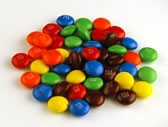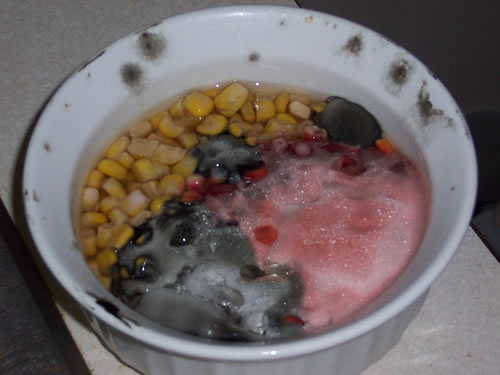Scaling Up Small Round Things
The next problem is easy, but don't skip it:
M&M's

How many m&m's are there in a one-pound bag, if a bag weighing 1/11 of a pound has 35 m&m's?
(To make this problem interactive, turn on javascript!)
- I need a hint ... : 11 of the little bags would go into one big bag
I think I have the answer: about 35*11 = about 400 m&ms.
Yes, I know 35*11 is 385, but do you really want to claim that a pound of m&m's contain exactly 385 pieces? Based on me eating -- I mean, counting -- a single fun-size pack?
Also, notice in this problem I didn't tell you how much the small bag weighed, only that it contained 1/11 of the amount of a large bag. Still, you probably found it easy to determine that you needed to multiply by 11. This is called "multiplying by the reciprocal."
Reciprocal, in this case, means what you get when you flip a fraction upside down. It's the "over" part of "one over eleven".
And (yes, this is a biology class):

Bacterial contamination:
Some students are measuring bacterial contamination. They take a very small sample of the contaminated food -- about one-ten-thousandth (1/10,000) of the container -- and count 49 bacterial cells. How many bacteria were in the original container of food?
(To make this problem interactive, turn on javascript!)
- I need a hint ... : The students took a 1/10,000 sample, so what do they need to multiply by?
- ...another hint ... : Multiply the number found by the reciprocal of 1/10,000
I think I have the answer: about 490,000.
Again, when we say "about 490,000", we really mean "more than 485,000 but less than 495,000." There are statistical ways to determine exactly what range you think the anwer lies in, but we'll save that for a different module.
If you found this last problem easy, that's great. Multiplying by the reciprocal of your sample size is the heart of counting bacteria by the serial diluation method. The rest is just technique.
Speaking of technique ... just how did those students get a sample of 1 ten-thousandth of the bacteria in their food? I know kids have a hard time just dividing a cookie into 3 equal pieces. Well, that's where the technique comes in. Basically, it's awfully hard to divide something into teeny-tiny pieces unless you first blow that something up and make it huge. That's what the story on the next page is about...
Copyright University of Maryland, 2007
You may link to this site for educational purposes.
Please do not copy without permission
requests/questions/feedback email: mathbench@umd.edu